Hints: Pro User Formats
Scroll down for more
Formats in the “Pro User” category are Betamax, Betacam and Betacam SP (camera-size and mastering-size), DVCAM (all sizes), Mini HDV (1080i) and U-Matic (high and Low Band).
Just in case you aren’t sure what you’ve got, here are some of the formats we cover at The Video Copy Company, and a bit of info about each…just click on the pictures below.
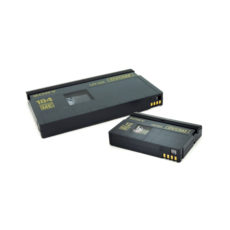
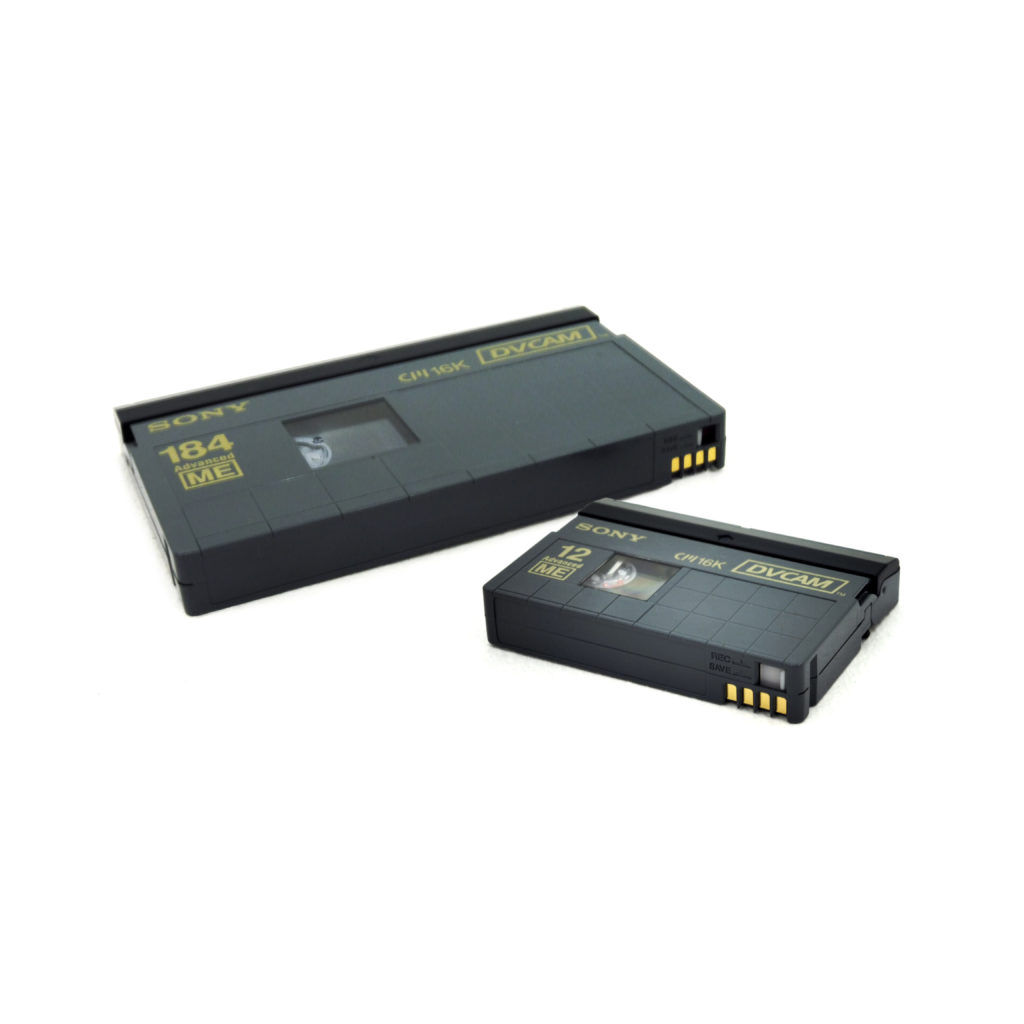
DVCAM (all sizes)
In 1996, Sony developed its own version of DV (Digital Video) called DVCAM. The two physical sizes of cassette available are identical to their standard DV counterparts, meaning you could use these standard tapes in a DVCAM machine and record in DVCAM mode. The difference being, DVCAM would run 50% faster than standard tapes, so for example, a 60-minute MiniDV tape recording in DVCAM mode would on get you 40-minutes of footage. This allowed for frame accurate editing and made it less likely to “drop” frames. Though the smaller tapes would record for 40-minutes, the larger tapes would record for 184 minutes (3 hours four minutes).
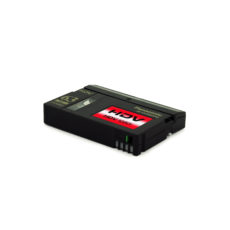
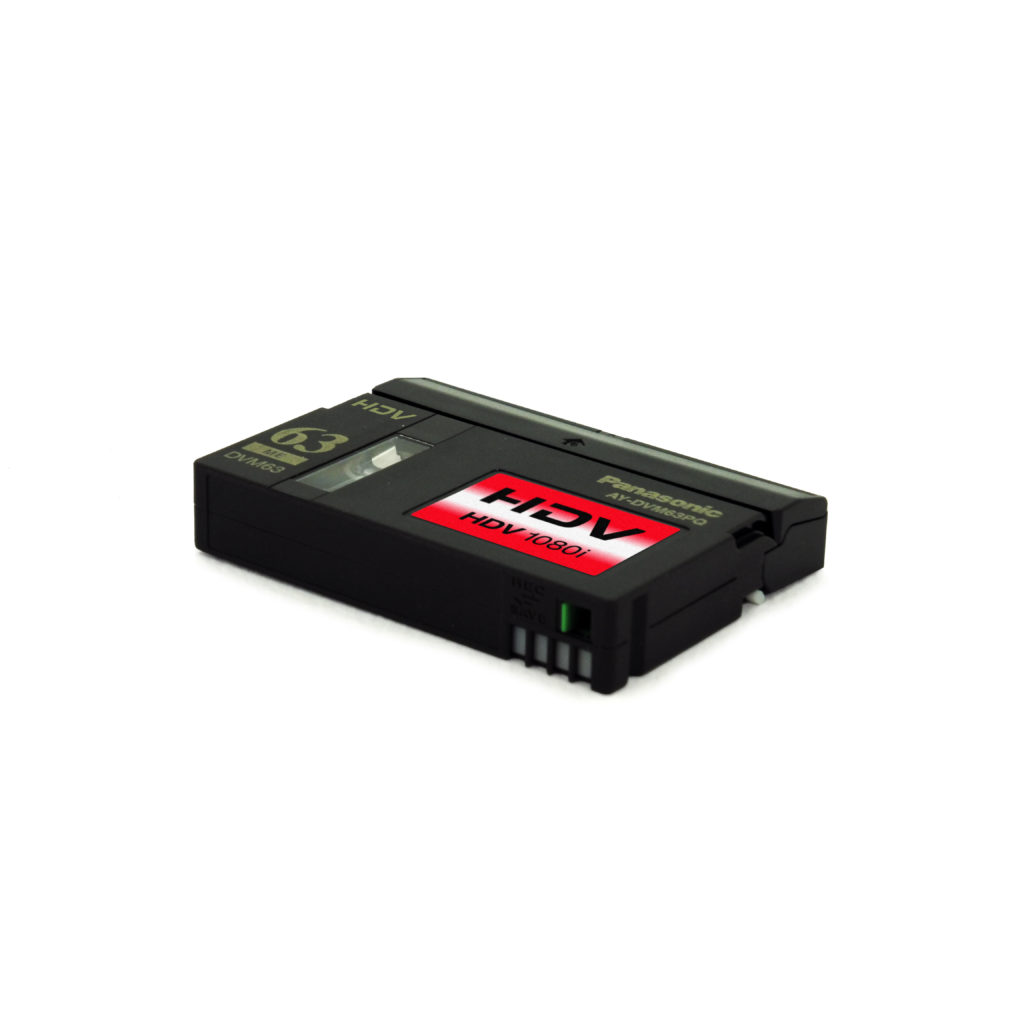
Mini HDV (1080i)
HDV is a video format for recording on High Definition digital video. This format was originally developed by JVC, but was supported by Sony, Cannon and Sharp.
These four companies joined together to form the HDV consortium in September 2003. Launched as an affordable high definition format for digital camcorders HDV quickly became popular with many amateur and professional videographers due to its low cost, portability, and image quality acceptable for many professional productions of the day.
HDV was developed with three different recording formats; 1080i, 1080p and 720p. In the UK, the standard for broadcast has always been 25 frames per second. 1080i would display 540 vertical lines 50-times per seconds, first the odd numbered lines, then the even numbered lines, interlacing the two together. This would give a smoother look to the video, but could make fast-moving content, like sport, appear blurry. 1080p would show the full 1080 lines all at once, 25 times per second, as would 720p, but in a smaller scale.
IMPORTANT – We are only able to transfer 1080i Mini HDV tapes, so it is advisable that you check the details either in your camera’s instruction manual, or it may be stated on the outside of the camera casing itself. If you have lost your manual, a quick internet search on the make and model of your camera should bring up the relevant details. If you are unsure, please contact us.
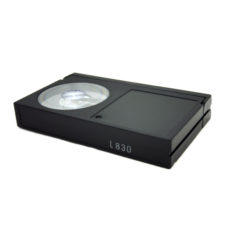
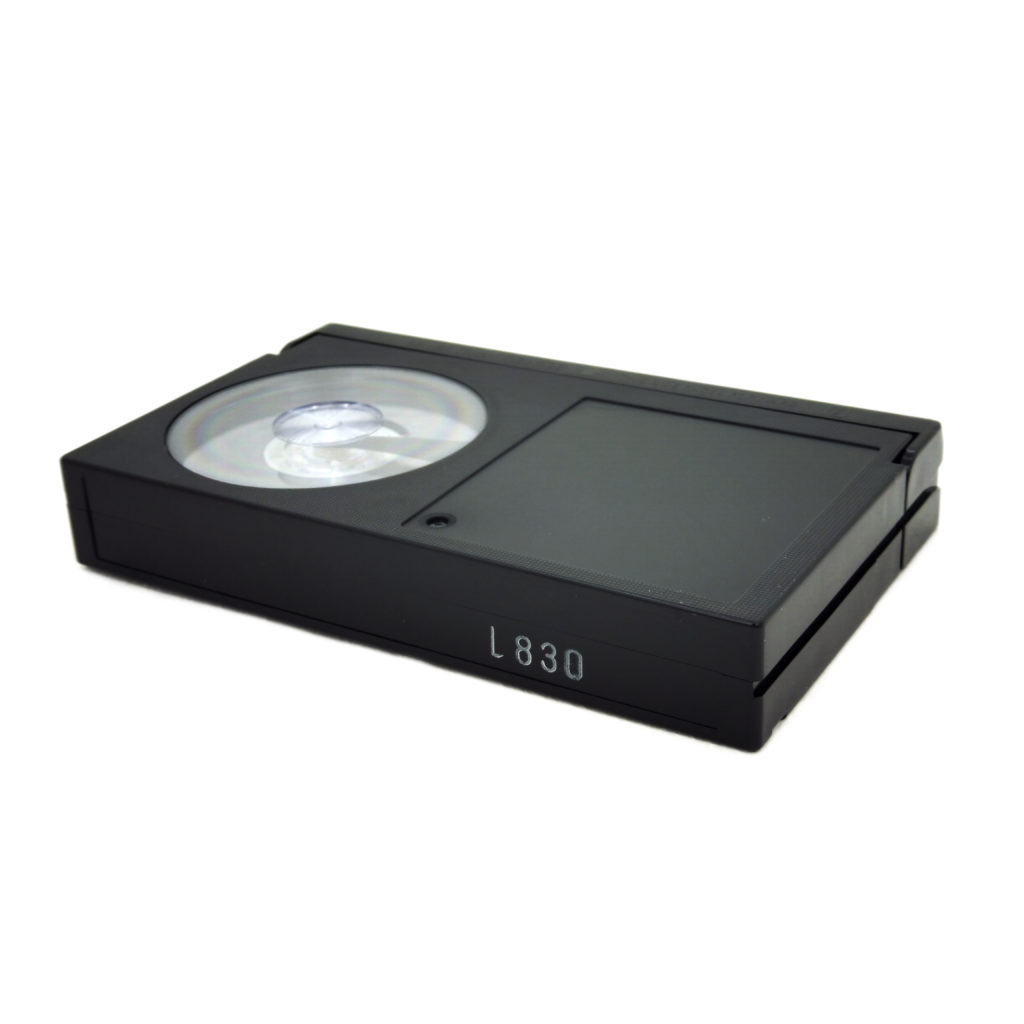
Betamax
Betamax was developed by Sony and released in 1975, and was the main rival to JVC’s VHS system. Compared to VHS, the size of the cassette itself was slightly smaller in length and width, but measured the same depth. It also provided slightly better video resolution than VHS (250 lines of detail, as opposed to 240). Though picture quality was a slight improvement, one of the main reasons Betamax lost out to VHS in the battle for the home video market was due to the recording duration of their tapes; they were shorter than VHS and so couldn’t fit long sporting events on. By 1980 the “format war” was all but over, with VHS holding 80% of the North American market, and Betamax having just 7.5%, even though longer tapes and long play functionality were later made available:
L-125 32 minutes
L-165 43 minutes
L-250 1 hour 5 minutes
L-370 1 hour 36 minutes
L-500 2 hours 10 minutes
L-750 3 hours 15 minutes
L-830 3 hours 36 minutes
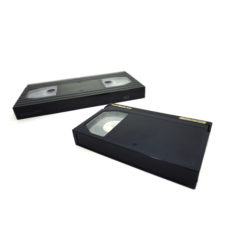
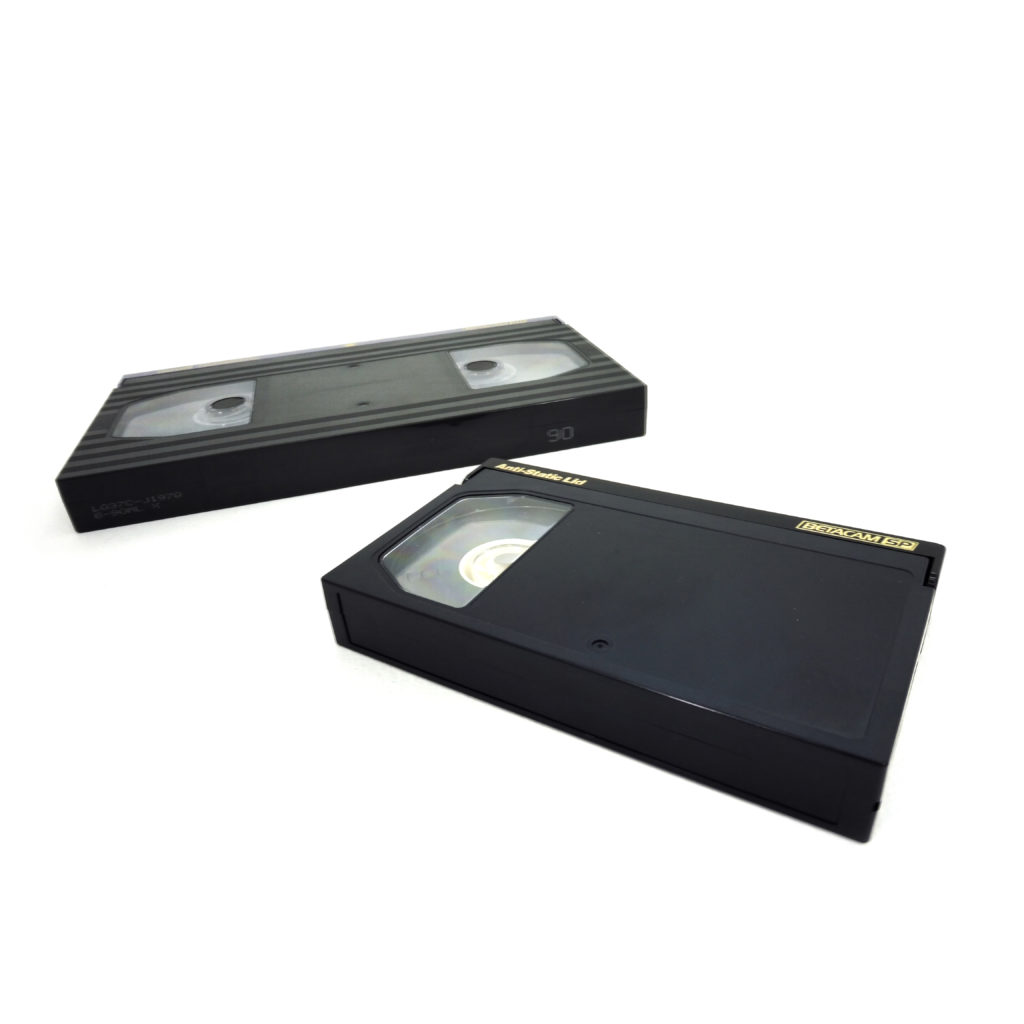
Betacam SP (camera-size and mastering-size)
Betacam SP was a developed by Sony as an improvement on their original Betacam system from the early 1980s. Though introduced in 1986, it was still being used as the go-to format for standard definition broadcasting all the way in to the 2000s. Boasting 625 lines, awesome colours and vastly superior audio quality, there was no other format that would take the crown away from Betacam SP for many years, until the advent of digital and High Definition.
Betacam SP tapes were available in a very limited range of recording durations. This was due to the high-quality tape within the cassette being much thicker. The smaller, 30-minute tapes were used in video cameras and the longer 90-minute tapes were used for mastering the completed edit using a playback or recording deck.
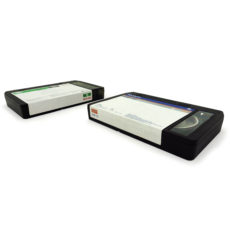
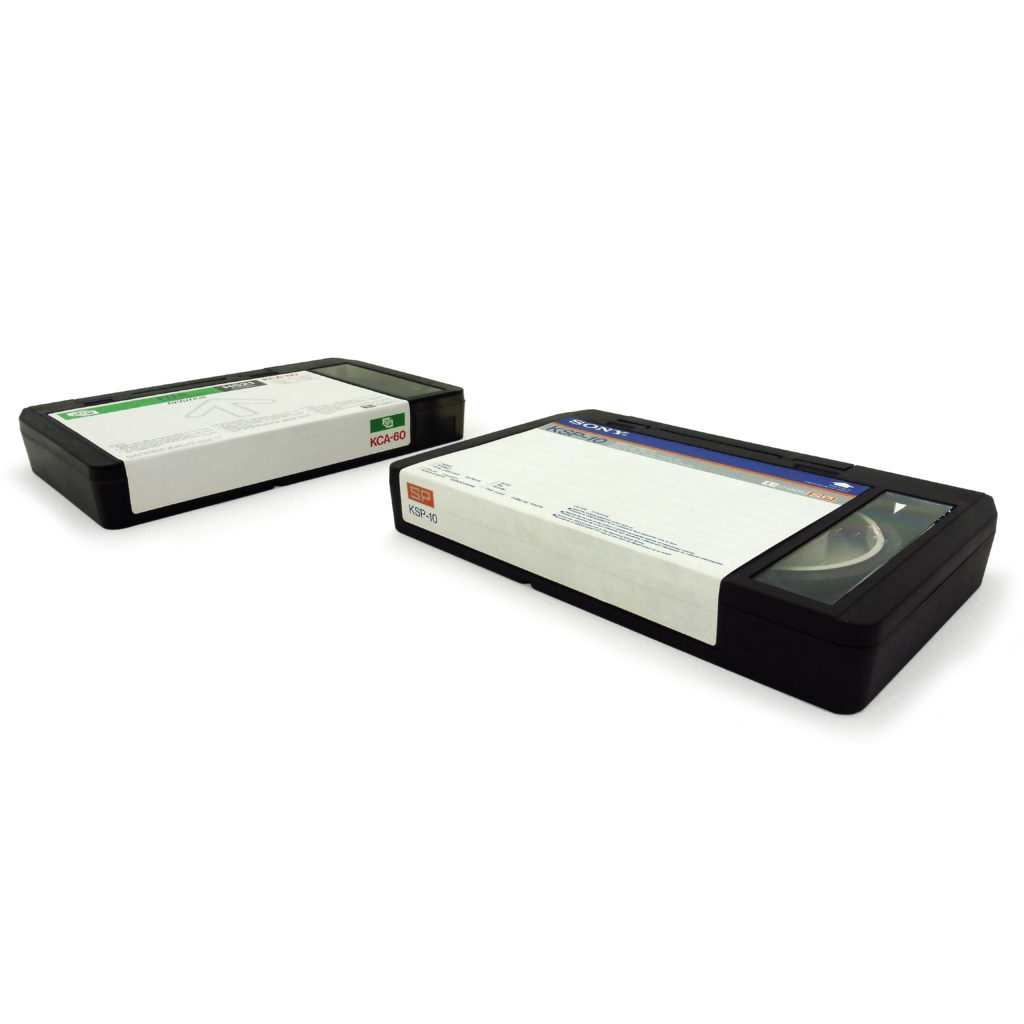
U-matic (Standard and SP)
U-matic was released in 1971 and was the successor to reel-to-reel video and was one of the first formats to have the videotape contained inside a cassette. The cassettes themselves were very large when compared to VHS and Betamax, which in turn, made the cameras and playback decks very large as well. As this format was mainly aimed at professional news gathering and broadcast organisations, this was not really seen as an issue.
Eventually, smaller tapes (U-matic S) were made available, and, much like VHS-C, would fit in to an adapter for playback in an edit deck. In the mid-1970s, Sony introduced an improved version of the U-matic tape dubbed “SP” or “high-band”, with the original iteration then referred to as “Standard” or “low-band”. U-matic SP boasted improved colour recording levels and less noise. This pretty much replaced 16mm film as the format of choice for news gathering organisations, and, several years later, Sony evolved U-matic SP into a new format called Betacam.
These formats demonstrate an evolution in terms of how professionals used and stored video, with each format being a significant change in the technology and quality from the last.
The U-matic system came out in 1971 and was the successor to reel-to-reel video. The cassettes themselves were very large and in turn, made the cameras and players large as well, but as this format was primarily aimed at professional video and television outfits, this was not seen as an issue.
Eventually, smaller tapes (U-matic S) were made available, which dramatically reduced the size of the cameras, and, much like VHS-C, these smaller tapes could be slotted into an adapter for playback in a full-sized edit deck.
In the mid-1970s, Sony introduced a further-improved version called U-Matic SP or “high-band”, the original version now being referred to as “Standard” or “low-band”.
U-matic SP boasted improved colour recording levels and less noise, and pretty much replaced 16mm film as the format of choice for news gathering organisations.
Betamax (though technically not classed as professional but certainly rare nowadays) was Sony’s rival format to JVC’s VHS. It was released in 1975, but was declared the loser in the format war by 1980.
Even though it was smaller in size and boasted slightly better video quality than VHS, one of the main reasons Betamax lost the battle for format supremacy was due to the Betamax tape’s limited recording duration upon its release, and Sony reluctance to compromise with a thinner tape for longer recordings.
Eventually, longer tapes were released, and even long play functionality was added to newer Betamax machines, but it was too little too late.
However, all was not lost with Betamax. By merging ideas from Betamax and U-matic, Sony released Betacam SP, which was developed in early the 1980s and released in 1986 and was the go-to format for broadcast and news gathering organisations all the way in to the 2000s.
Betacam SP cassettes came in two sizes; a smaller sized tape that was used with shoulder-mounted, industry-standard cameras (with prices starting from £4,000 each and going up to tens-of-thousands), and a larger tape that was used for mastering the final edit.
The smaller cassettes could run for around 30 minutes and the larger cassettes would run for around 90 minutes. Both sizes of cassette could be played back using a large industrial deck. The playback only deck would have cost around £4,000 and a playback/recording deck would cost around £6000.
Even with the advent of digital in 1995, Betacam SP would still be widely used into the early 2000s. Oddly, one of the main rivals to Betacam was another of Sony’s offerings; DVCAM.
DVCAM tapes come in two different variations; full sized and mini. Both versions record in the same digital way on the same width of tape, though the mini size looks identical to a MiniDV tape. In fact, you can use a MiniDV tape to record DVCAM footage, except in this mode a 60 minute MiniDV tape will only give you 40 minutes’ duration.
The larger format of DVCAM tape can also be used in some high-end professional cameras, but will get you much longer recording durations.
DVCAM was a very popular format amongst professionals for a number of years; mainly due to the format’s stability. It would run the tape over the heads much faster than MiniDV for example, leading to much fewer drop-outs and lost frames, as well as allowing for frame-accurate insert-editing, which was not always possible with regular DV.
It would also use a function called “locked audio”, which prevents video and audio sync issues when further copies are made.
When the digital video world started to change from Standard Definition to High Definition, a number of ways to record HD were released; 720p, 1080i and 1080p, as well as a variety of ways to record them down onto either tape or solid state memory.
One of the cheapest ways was to record the footage onto already existing technology, like DV and MiniDV tapes.
Sony adopted the 1080i variant of HDV, and released a series of cameras that used Mini HDV tapes to capture the footage. The beauty of these cameras was that the user could insert a regular MiniDV tape and still record HDV footage. This made the transition to HDV much more affordable than the solid state memory card cameras that were also available.
Given the price and quality of footage, these cameras were, for a time, adopted by news gathering organisations and professionals, meaning that, generally speaking, the footage was of broadcast quality.
That’s the brief history lesson over with!
Some of these formats – especially from the U-Matic – can prove to be quite bulky, and if you have different formats cluttering up your shelves, getting these tapes transferred to some other media can free up lots of space. Not to mention the longer you leave these tapes lying around, the more chance there is of them succumbing to damage and the risk of losing these precious memories forever.
Here at The Video Copy Company, we provide various options when it comes to backing up your Pro User Format tapes;
The most common conversion that we do here is a Video to DVD Transfer. This involves running the video tape through one of our industrial video players and into a machine which will convert the video from, in most cases, an analogue signal into a digital one, burning it onto a DVD-R disc.
We offer two different types of DVD-R disc; Standard DVD-R and Gold Archive DVD-R.
DVD-R was introduced in 1997 by Pioneer and is supported by most DVD players (there is another format called DVD+R which is supported by fewer DVD players. It is important you know which format your DVD player prefers as we cannot be held responsible for converting to the wrong format). We can convert to DVD+R but you must let us know you require this format before we do the conversion.
DVD-R was supposed to supposed to last forever, but it was later discovered that this was not the case. The data burnt to a Standard DVD-R can last between 2-10 years. Sometimes more, sometimes less. At The Video Copy Company, we only use A-grade discs, so our recordings should last 10 years or more.
Gold Archive DVD-R was then developed, which uses layers of real gold and silver to lock the burnt-in information to be hold in place for up to 100 years. You can find out more in-depth information about the differences between Standard and Gold Archive DVD-Rs here…
Though the picture quality, audio quality and storage size are all the same, and both discs can be physically damaged with scratches and finger prints, a well stored Gold Archive DVD-R should last for generations.
An increasingly more common conversion that we also do here is a Video to MP4 Transfer. This involves running the video tape through one of our industrial video players and into a computer, which will then convert the video file into a format that the general public can easily handle, such as MP4.
We can convert the video into other formats, such as MPEG2, AVI, Quicktime, to name but a few. It depends what you want to do with the video and how much storage space is available. If you bring in HDV tapes, then we can either keep your videos in HD resolution or down-convert them to standard definition.
MP4 is the most common format used as it is compatible with most modern smart TVs, PCs, Macs, smartphones, tablets, video game consoles and so on.
Once your videos are converted, they can then be copied to a USB device like a pen or an external hard drive, depending on how much footage you have. We like to convert videos to a high quality MP4 file as this will be suitable for re-editing in the future and will look great on high quality TVs. When deciding how much storage space is required, one hour of footage takes up roughly 6GB of space.
It is also important that you let us know if you are using a PC or a Mac as the two systems may require the pen or hard drive to be formatted in a different way. You can find more information about external storage devices here.
